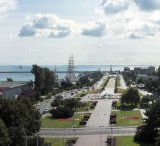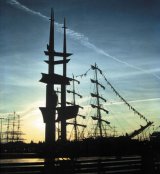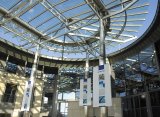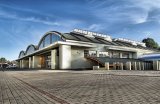|
GDYNIA
There are many good reasons why Gdynia is a meeting place for people whose main concern is economic development and strengthening of international economic ties based on both knowledge and experience.
Gdynia is a vigorous city - open-minded and beautiful. People here are enterprising and are looking for new opportunities for development; in maritime economy which Gdynia has always been associated with, but also in finance, the labour market, the tourism industry and the relations with Scandinavia - all based on modern information technologies.
***

In Gdynia, which is often referred to as the city of business, it is small and medium-size enterprises that prevail. They make Gdynia dynamic and modern.
The number of business entities registered in Gdynia is constantly growing. The growth is particularly fast in the sector of finance, consultancy, brokerage, R&D and data processing – 25 per cent of all businesses in Gdynia, while the national average is 17 per cent.
In the city with a population of a quarter million, there are as many as 1,520 businesses dealing with financial brokerage.
Gdynia is a city of banks. Nordea Bank Polska S.A. has its head office here, while the total number of bank branches, sales points and agencies is 105 and has an upward trend.
Prospects for the emergence of a new business district in Gdynia, hosting banks, hotels, shipping, brokerage, insurance and exhibition companies are more and more likely to materialise soon. This is the so-called City Centre Development Zone - an area of 100 hectares of disused rail tracks. Before WW2 this was sort of port's coal-storing facility on rails, where coal brought from inland Poland (Silesia) waited to be loaded on vessels. As the port's functions have changed, the area seems to have an attractive future.
In fact, not many European cities of the size of Gdynia have such attractive land for development situated in the city centre. When privatisation of the Polish Railway (PKP) is completed, it will be possible to develop this area into a business district, the main attraction of which will be the proximity of both – the port and the city centre, with all its amenities.
***

Gdynia is the most maritime of Polish cities. The maritime economy has for years been employing about 40 per cent of its population. This is the natural consequence of the geographic location of the city and its infrastructure, and according to city planners, this will continue.
The port is one of the most modern in the Baltic, owing to the investment projects in the two container terminals, the bulk terminal and the ferry terminal. The year of 2007 was record-breaking for the Port of Gdynia, as 17 million tonnes was handled. It was the best result in the whole history of the port. Since the beginning of the century the cargo volume handled in Gdynia has doubled.
Ferry connections and cruise ship traffic are also becoming more and more important for the Gdynia port. A new ferry terminal is going to be build in Gdynia soon.

New prospects for the port and the firms operating in or cooperating with it as well as for the city itself will be offered by the completion of the A-1 motorway which, along with the newly built Kwiatkowski route, provides the port with easy connection to the international road network.
Four shipyards and a multitude of forwarding, brokerage, fisheries and fish processing companies have complemented the maritime picture of Gdynia ever since it was founded over 80 years ago.
***
The significance of the tourism industry for Gdynia is growing, too. More and more foreign visitors discover the natural attractions of Gdynia and its broad cultural offer. They come here not only by road or rail, as they always did, but also by sea - by ferry from Karlskrona in Sweden and by cruise ships. Owing to the budget airlines and the proximity of the Lech Wałęsa Airport, more and more are flying in. Moreover, a new passenger airport is being built in Gdynia-Kosakowo.
| |
Figures speak for themselves: in 1992, about 161 thousand visitors came to Gdynia by sea while the respective figure for 2005 was nearly 558 thousand. In 2005, nearly 226 thousand visitors availed themselves of the Gdynia hotels or boarding houses.
The summer of 2006 marks the launch of the region's new tourist product – the water tram to the Hel Peninsula. Owing to financial support from the regional government and the local governments of Gdynia, Jastarnia and Hel, there is now a low-priced alternative to car journey. It has a development potential because it may obtain EU funding as a tourism booster of subregional, Baltic dimension.

Business tourism is also developing in Gdynia, especially in low season. Organisers of congresses, economic fora, scientific conferences, international political meetings or party conventions often choose Gdynia as the venue for their events. This is the case with this International Economic Forum, the International Cardiosurgical Congress, or the International Congress of City Planners.
Gdynia has good resources, including human resources; besides it has made a name for itself and has huge development potential. The Waterfront Zone between the Gulf of Gdańsk and the forest-grown cliff, in the vicinity of the city centre, is an area which is not yet closed in terms of land use. It is therefore a challenge for the best – project sponsors and architects, as only quality buildings will be allowed here.
This is the area of Skwer Kościuszki, with the quay berthing the greatest tall ships and cruise ships of the world; with the picturesque marina, the Aquarium, a planetarium, a promenade, the Musical Theatre and the new facilities of the City Museum of Gdynia and the Naval Museum. It is also here, only 12 metres from the shoreline, that stands the Sea Towers compound. With its height of 138 metres, it is one of the tallest apartment buildings in Poland, an architectural landmark of Gdynia and a new tourist attraction.
***
 Gdynia is among Polish cities with the lowest unemployment rate – 4.1% in June 2007, which is the best barometer of the economic condition.
Dynamism, entrepreneurship, ambition, activity, adaptability, competence – they have all been present in the labour market of Gdynia, among employees and employers alike.
It is owing to these characteristics that between 1926 and 1939 Gdynia was transformed from a small village to a city with a population of over 100 thousand. This heritage is still alive.
What matters is a good climate for good ideas. Initiatives of the local government aimed at stimulating the development of the city quickly take root here. The most recent of such initiatives is the www.innowacje.gdynia.pl project, co-funded by the European Social Fund. The goal of the project is to boost the competitiveness of the region through the creation of a network of cooperation between companies, facilitating the transfer of know-how and technology, particularly in biotechnology, ICT, maritime and shipbuilding industries, environmental protection and business environment.
***
One of Gdynia’s promotion slogans is GDYNIA TRADITIONALLY MODERN. And indeed, companies representing the sector of new technologies are growing rapidly.
The place where the ambitious and daring are particularly welcome is the Pomeranian Science & Technology Park (PPNT).
This is also a place and an institution building bridges between the research community and organisations, the local community and entrepreneurs and investors ready to put their money in technologically advanced projects. The objective of the whole project is to raise the share of development industries in the local labour market; create new jobs in manufacturing and services and reduce the dependence of the SME sector on the economic performance of large companies from the maritime sector. A very attractive and well-equipped space has been organised in the office building and former bus depot, owing to the initiative of the local government in Gdynia and the financial support from the EU. It accommodates exhibition halls, the Bio Lab Centre, prototype units and conference rooms.
The official opening ceremony will be held in September 2006, yet for some time more and more companies have been working on challenging and market-oriented projects, approved by the PPNT Science Council. On 20 July 2006 there were already forty-seven IT, biotechnology and industrial design companies in the Park.

Companies at the Park are winners of prestigious contests. Ivo Software and Astcom Rozwiązania Informatyczne, for example, are the winners of the BUSINESS PLAN OF GDYNIA contest, in 2003 and 2006 respectively. This is a contest encouraging young start-ups, implementing innovative, market-oriented projects.
All companies at the PPNT can count on the support of the City Hall, which is the organiser and the sponsor of the project. Apart from reduced rent for the use of the infrastructure, the City Hall also provides training for the companies, free of charge.
| |

